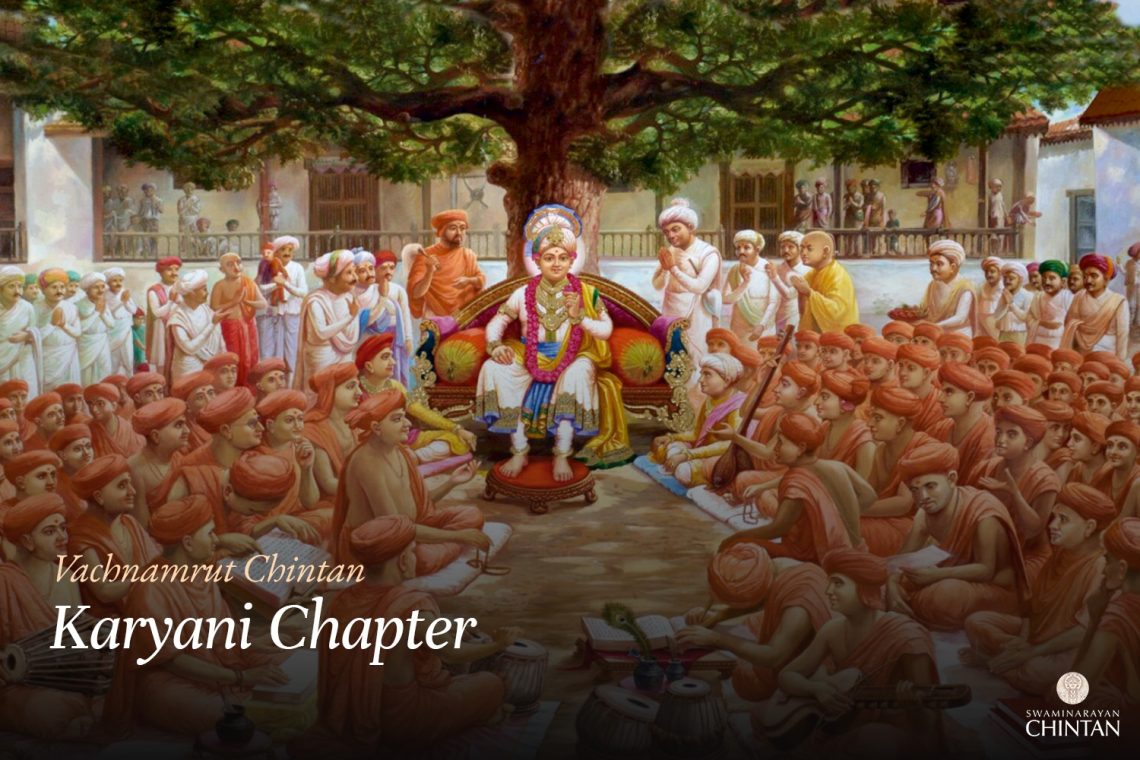Central Insights:
- Conviction in Bhagwan.
Main Points:
- Establishing a relationship with Bhagwan, recognizing that “Bhagwan is mine, and I belong to Bhagwan,” is the essence of Nishchay.
- Nishchay first occurs in the Indriy, then in the Ahankaran, then in the Chitt, then in the Man, ultimately reaching the Buddhi, and finally, it is established in the Jeev.
- When Nishchay is firmly rooted in the Jeev, it remains unshaken even if Bhagwan exhibits any form of Charitra.
Commentary:
This Vachanamrut emphasizes Nishchay (conviction). In this discourse, Bhudharanand Swami asked whether Nishchay in Bhagwan happens in the Antahkaran or in the Jeev (soul). In response, Shreeji Maharaj explained that Nishchay occurs in the Buddhi (mind). Maharaj provided a detailed explanation, stating that the Jeev comprehends everything through the Buddhi. Thus, the Buddhi permeates the entire Antahkaran and the Indriy (senses). Since the Jeev pervades the Buddhi, Nishchay established in the Buddhi also establishes Nishchay in the Jeev. The Buddhi is connected to all the Indriy, and therefore, it perceives the experiences and knowledge received through them. When these perceptions and knowledge pass through the Indriy and the Antahkaran, they undergo refinement, and the Buddhi recognizes this refined knowledge. After passing through the Buddhi, this flow of knowledge reaches the Jeev, transforming the Nishchay formed in the Buddhi into an indelible conviction in the Jeev.
Maharaj explains that Nishchay first occurs in the Indriy, then in the Ahankar, then in the Chitt, then in the Man, then in the Buddhi, and finally in the Jeev. This process of Nishchay is highly subtle, making it difficult to detect its variations. The Indriy perceive objects as they are, relaying this information to the Antahkaran. Subsequently, Maharaj states that Nishchay occurs in the Ahankar. The knowledge received through the Indriy is processed by the Ahankar, which differentiates between what is ‘mine’ and what is ‘others’. The Ahankar processes this knowledge, establishing a sense of ownership and connection with the object or concept, particularly when it concerns Bhagwan.
When the knowledge related to Bhagwan’s personality reaches the Ahankar, it establishes a relationship, acknowledging that “this is mine,” and associates with it. This knowledge is then passed on to the Chitt, which adds its own interpretation, visualizing that the relationship established by the Ahankar is correct and beneficial. Maharaj then explains that Nishchay occurs in the Man, which focuses its tendencies, determining that this is good and endorsing the decision made by the Ahankar. Subsequently, when this process reaches the Buddhi, the Buddhi carefully evaluates all aspects, calculating gains and losses, and finally solidifies the knowledge as beneficial for the Jeev. The Jeev then integrates this knowledge as a firm, unwavering conviction.
The Indriy are capable of perceiving and transmitting information, while the Buddhi is responsible for evaluating this knowledge. The Jeev is inherently a perceiving entity, constantly observing both the presented knowledge and the Buddhi itself, regardless of whether the Buddhi actively presents anything or not. This unceasing observation indicates that the Jeev remains perpetually active, unlike the Buddhi, which alternates between active and inactive states depending on whether it is engaged in processing information. The Indriy, on the other hand, must be turned on or off depending on whether they are engaged in perceiving external objects.
Now, it is essential to understand the process of knowledge acquisition. Knowing an object as it truly is constitutes knowledge. As stated, “वस्तु तन्त्रं भवेत् ज्ञानम्”— vastu tantram bhavet jñānam, the Buddhi, Indriy, and Antahkaran concentrate on an object, perceiving it as it truly is, and this is considered knowledge. In the process of Nishchay, the first step is generally acquiring knowledge about Bhagwan, followed by recognizing His greatness, which involves comparing and appreciating the superiority of Bhagwan over everything else. This comparative knowledge is known as Mahima, and the process of Nishchay begins thereafter.
When we recognize that an individual possesses unique or significant qualities, we are inclined to establish a relationship with them. The Antahkaran attempts to establish such a relationship, recognizing them as superior and forming a sense of belonging, and this decision is what we call Nishchay in relation to Bhagwan. When this relationship is established, it is accompanied by attachment and affection, leading to the development of Bhakti, which is characterized by devotion. Following this, the quality of Nishtha (steadfastness) emerges, which refers to an unwavering commitment to Bhagwan until death, regardless of any challenges. Nishtha is recognized after enduring long periods and traversing difficult circumstances.
Subsequently, the process of Upasana (worship) begins, where the relationship established with Bhagwan as a servant-master connection is recognized as eternal. This eternal relationship is acknowledged and accepted with firmness, and this is known as Upasana. As mentioned by Shreeji Maharaj in the Shikshapatri, “तत्र ब्रह्मात्मना कृष्ण-सेवा मुक्तिश्च गम्यताम्।” — tatra brahmātmanā kṛṣṇa- sevā muktiś ca gamyatām, establishing this eternal servant-master relationship with firm conviction is the process of Upasana. It emphasizes principle over emotional sentiment and is more philosophical in nature. Understanding this process of Nishchay requires comprehending each stage, as they are sequential, interrelated, and assist in recognizing one another.
Finally, Nityanand Swami asked Maharaj, “How do we know if Nishchay has occurred in the Indriy, the Antahkaran, or the Jeev?” To which Shreeji Maharaj responded that if we see good and bad objects, auspicious or inauspicious events, pleasant or unpleasant experiences in Bhagwan, and yet do not doubt Him, then we can say that Nishchay has occurred in the Indriy. This response serves as a test for Nishchay. We have established our relationship with Bhagwan, acknowledging His goodness. However, if Bhagwan, while manifesting in human form, occasionally performs actions that do not align with our expectations, or if He tests us by performing actions that seem inappropriate to us, and yet our relationship with Him remains unshaken, recognizing these actions as divine play (Leela), then we can say that Nishchay has occurred in the Indriy. If the three qualities of Maya (Sattva, Rajas, Tamas) are observed in Bhagwan, but our conviction remains firm, then we can say that Nishchay has occurred in the Antahkaran.
The reason for Nishchay being shaken is the presence of Tamogun qualities like laziness or sleep in Bhagwan, which we might not question, but if we experience them ourselves, we may find it difficult to accept. Similarly, if we observe Rajogun qualities like lust or anger in Bhagwan, and we are the recipients of such actions, it may challenge our faith. However, if we do not doubt Bhagwan despite such situations, then Nishchay has occurred in the Antahkaran. Maharaj mentioned that Bhagwan Rishabhdev wandered in a state of complete Nirvikalp Samadhi, holding a stone in His mouth, while His body burned in a forest fire, yet He remained unaware. If we experience hardships as a result of such divine actions and still do not doubt Bhagwan, then Nishchay has occurred in the Jeev. Once Nishchay is established in the Jeev, it cannot be shaken. Maharaj illustrated this concept using the example of a ship’s anchor.
Later, Chaitanyanand Swami asked, “Maharaj, Bhagwan is beyond the reach of the mind and speech, and He is Gunatit. How can the Mayic (wordily) senses and Antahkaran perceive Him?” Maharaj replied that Bhagwan creates, sustains, and dissolves the universe solely for the benefit of the Jeev, without any self-interest. He guides the Jeev through different states of consciousness, such as Sushupti (deep sleep), and propels the Pradhan Purush and others into action during creation, solely for the welfare of the Jeev. With such compassion for the Jeev, when Bhagwan incarnates as a human, His heart is filled with immense grace and compassion for the Jeev. With such a divine resolve, He ensures that even ordinary souls can recognize Him, establish Nishchay, and seek refuge in Him. Thus, the Jeev can indeed perceive Bhagwan through the grace bestowed by Him, rather than through their own efforts.
Then Bhajananand Swami asked, “Maharaj, why do the scriptures state, “यतो वाचो निवर्तन्ते अप्राप्य मनसा सह।” — yato vāco nivartante aprāpya manasā saha; (Taittiriya Upanishad 2.4.1).Shreeji Maharaj responded pleasantly, saying, “Just as the Earth is sustained in the sky but does not attain the qualities of the sky, similarly, the Man and speech, though sustained by Bhagwan, do not attain His qualities.”
Nityanand Swami then asked, “Maharaj, the scriptures also say, “निरञ्जनः परमं साम्यमुपैति।” — nirañjanaḥ paramaṁ sāmyam upaiti; (Mundaka Upanishad 3.1.3) and “बहवो ज्ञानतपसा पूता मद्भावमागताः — bahavo jñānatapasā pūtā madbhāvam āgatāḥ; (Bhagavad Gita 4.10) ” How do we reconcile this?” Shreeji Maharaj replied, “What I mentioned applies to the Man, Indriy, etc., of non-devotees of Bhagwan. However, the Man and Indriy of a devotee can indeed realize Bhagwan. Just as during the time of Pralay, the Earth becomes one with the sky, and all elements merge into the sky, similarly, the body, Indriy, Antahkaran, and Pran of a devotee, through knowledge of Bhagwan, become one with Bhagwan and attain divinity. Just as a worm, through constant association with and meditation on a wasp, becomes a wasp, a devotee too, in this very body, becomes one with Bhagwan.
In this way, the Indriy and Antahkaran of a devotee realize Bhagwan. However, it is crucial to understand that they do not undergo any change in their fundamental nature. They remain perishable and subject to change. Therefore, the scriptures state that they do not attain Bhagwan because Bhagwan’s Vigraha (divine body) is not like ours; it is unchanging and eternal. Thus, while the Indriy and Antahkaran of a devotee may attain divine qualities, they do not become identical to Bhagwan’s divine form. However, through the knowledge, worship, and Upasana of Bhagwan, the Mayic nature of the Indriy, Antahkaran, and body of a devotee is diminished to the point where they embody divine qualities. Their thoughts, actions, and emotions become divine, free from any Mayic influence, thereby allowing them to realize Bhagwan in this very body.
Maharaj concludes by saying that this happens only to those who are steadfast in Bhakti along with Atmajnan (knowledge of the self) or solely in Bhakti. However, those who are only focused on Atmajnan attain Brahmasatta (a state of unity with the Brahman) but do not become one with Bhagwan.
Glossary
| Nishchay – Firm Faith in Manifested God Believing Manifested God (Bhagwan Swaminarayan) as “My Beloved God” (My Istadev) |
| Indriy – Senses |
| Ahankar – Ego |
| Chitt – Consciousness or mind The aspect of the mind that clings to and takes the shape of objects it remembers or perceives. |
| Man – Mind The inner faculty that processes sensory input and generates thoughts and emotions. |
| Buddhi – Intellect |
| Jeev – Soul The individual living entity, distinct from the body and mind, that experiences life and karma. |
| Antahkaran – Inner faculties The mind, intellect, consciousness, and ego, which help in acquiring spiritual knowledge. |
| Upasana – Worship and devotion The practice of deep meditation and attachment to Bhagwan. |
| Mahima – The understanding of Bhagwan’s supreme glory, inspiring steadfast devotion and loyalty. |
| Bhakti – Devotion Loving and selfless worship of God. |
| Nishtha – Firm faith The deep and unwavering belief in Bhagwan’s greatness, which solidifies one’s spiritual path and devotion. |
| Brahmasatta – State of unity with Brahman |
| Paramatma – Supreme God God, the all-pervading and ultimate reality. |
| Vigraha – Divine body |
| Nirañjanaḥ Paramam Sāmyam – Scriptural verse, From the Mundaka Upanishad, stating that the pure soul attains oneness with Bhagwan. |

